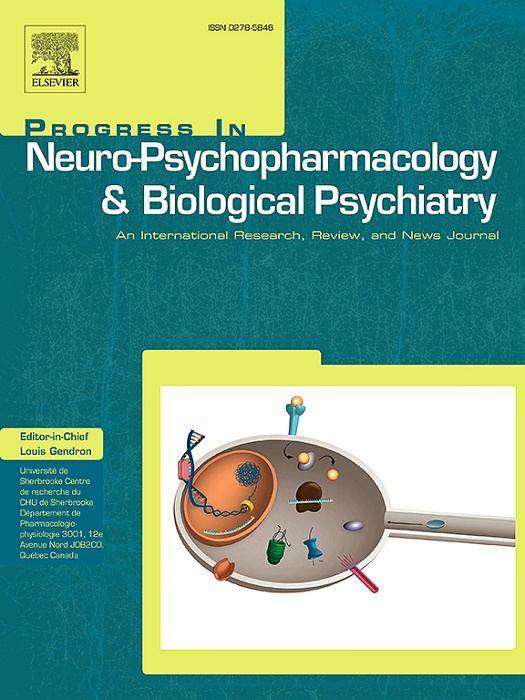lnc15qD3 expression in the NAc shell regulates the reconsolidation of opioid reward memories
IF 3.9
2区 医学
Q1 CLINICAL NEUROLOGY
Progress in Neuro-Psychopharmacology & Biological Psychiatry
Pub Date : 2025-06-30
DOI:10.1016/j.pnpbp.2025.111433
引用次数: 0
Abstract
Following memory retrieval, permanent drug memories become unstable and easily disrupted, followed by reconsolidation; this pattern holds promise for treating substance use disorder (SUD). Recent research has demonstrated that epigenetic modifications, including long noncoding RNA (lncRNA) regulation, participate in learning and memory. However, the role of lncRNAs in drug-memory reconsolidation remains unclear. Here, we found that in conditioned place preference (CPP) and self-administration (SA) mouse models of drug abuse, lnc15qD3 expression was substantially upregulated after contextual cue exposure in the nucleus accumbens (NAc) shell but not in the core. Furthermore, after retrieval, viral-mediated knockdown of lnc15qD3 disrupted the reconsolidation of morphine-induced CPP memories in the NAc shell but not in the core. Additionally, the inhibitory effect cannot be reversed by time or morphine priming. Similarly, using a heroin SA protocol, lnc15qD3 knockdown in the NAc shell after retrieval long-term suppressed heroin-seeking behaviors. We further investigated the molecular events downstream of lnc15qD3 mediating the reconsolidation of opioid reward memories in rescue assays and in vitro experiments. Our results indicated that lnc15qD3 binds to endogenous miR-7118-5p/miR-6914-5p, which alters the expression of Notch2 and regulates opioid addictive memory reconsolidation. Consequently, lnc15qD3 may be applied as a target for anti-relapse therapy.
lnc15qD3在NAc壳中的表达调节阿片奖励记忆的再巩固
记忆提取后,永久性药物记忆变得不稳定,容易被破坏,随后是再巩固;这种模式有望治疗物质使用障碍(SUD)。最近的研究表明,表观遗传修饰,包括长链非编码RNA (lncRNA)调控,参与学习和记忆。然而,lncrna在药物记忆再巩固中的作用尚不清楚。本研究发现,在条件位置偏好(CPP)和自我给药(SA)药物滥用小鼠模型中,情境线索暴露后,lnc15qD3在伏隔核(NAc)外壳中的表达大幅上调,而在核心中则没有上调。此外,在检索后,病毒介导的lnc15qD3的敲低破坏了吗啡诱导的CPP记忆在NAc壳中的再巩固,而不是在核心中。此外,抑制作用不能被时间或吗啡启动逆转。同样,使用海洛因SA方案,lnc15qD3敲低NAc壳后,长期抑制海洛因寻求行为。我们通过救援实验和体外实验进一步研究了lnc15qD3下游介导阿片奖励记忆再巩固的分子事件。我们的研究结果表明,lnc15qD3结合内源性miR-7118-5p/miR-6914-5p,改变Notch2的表达,调节阿片成瘾记忆的再巩固。因此,lnc15qD3可以作为抗复发治疗的靶点。
本文章由计算机程序翻译,如有差异,请以英文原文为准。
求助全文
约1分钟内获得全文
求助全文
来源期刊
CiteScore
12.00
自引率
1.80%
发文量
153
审稿时长
56 days
期刊介绍:
Progress in Neuro-Psychopharmacology & Biological Psychiatry is an international and multidisciplinary journal which aims to ensure the rapid publication of authoritative reviews and research papers dealing with experimental and clinical aspects of neuro-psychopharmacology and biological psychiatry. Issues of the journal are regularly devoted wholly in or in part to a topical subject.
Progress in Neuro-Psychopharmacology & Biological Psychiatry does not publish work on the actions of biological extracts unless the pharmacological active molecular substrate and/or specific receptor binding properties of the extract compounds are elucidated.

 求助内容:
求助内容: 应助结果提醒方式:
应助结果提醒方式:


